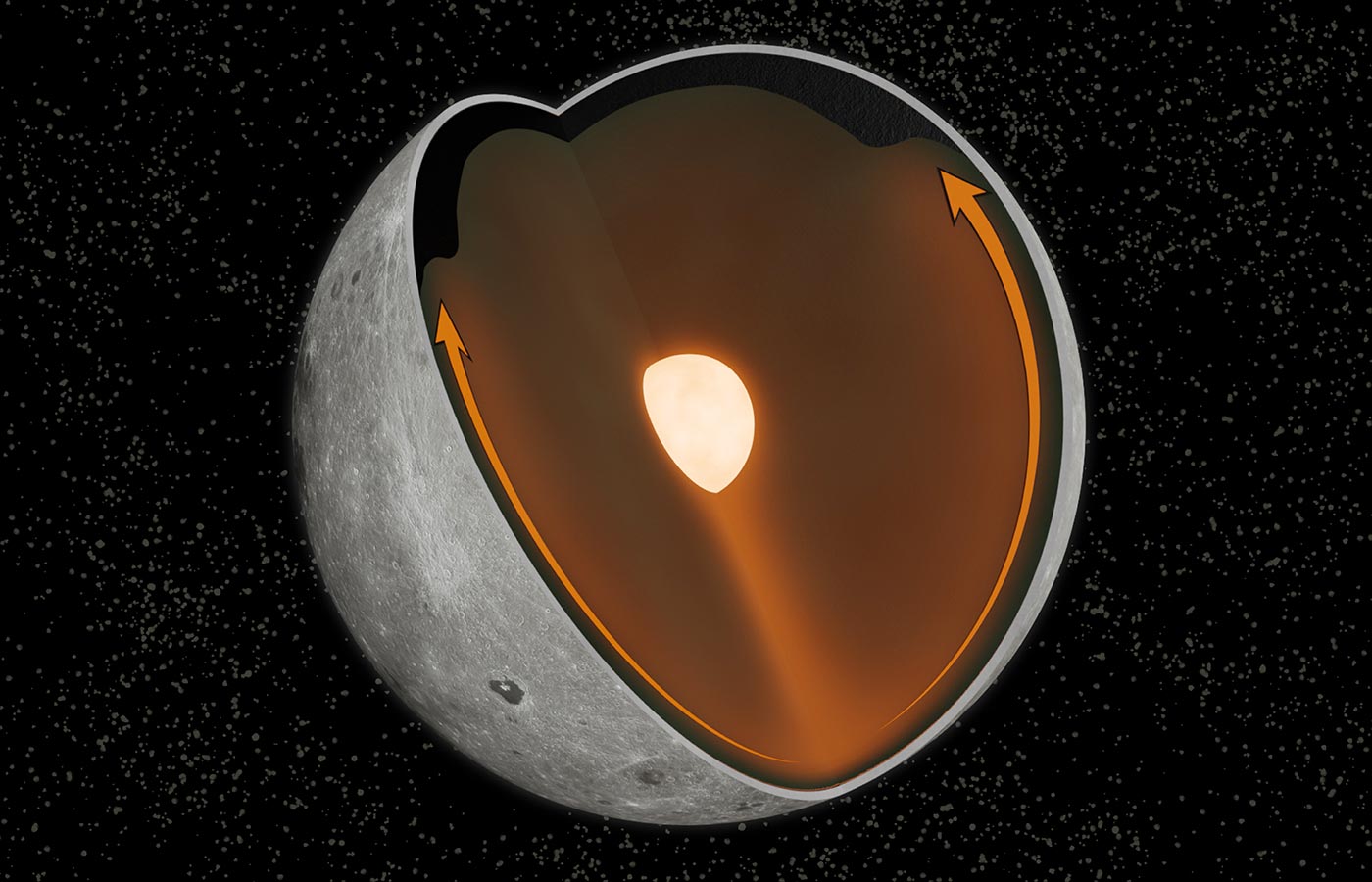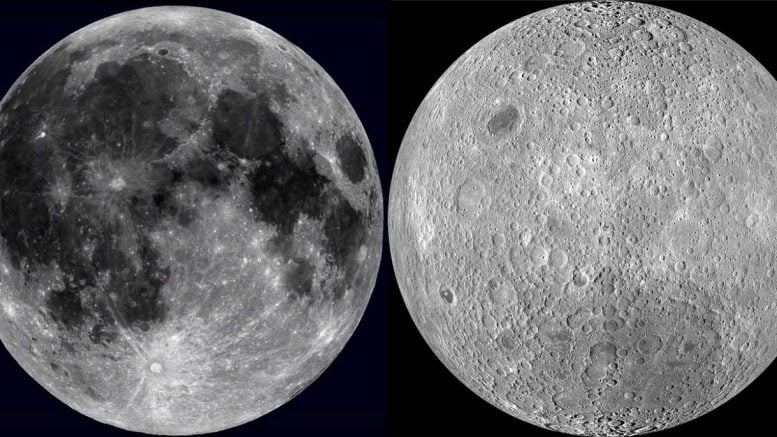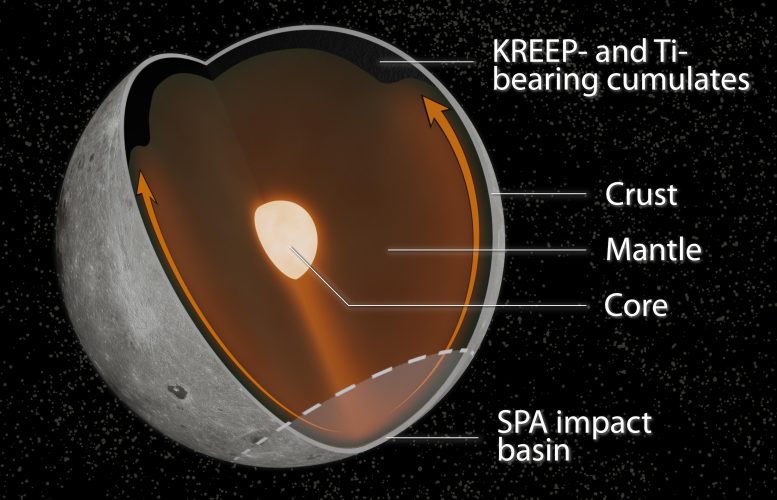
Нове дослідження показує, що стародавнє зіткнення на південному полюсі Місяця змінило конвекційні моделі в місячній мантії, зосередившись на групі елементів, що виробляють тепло, на ближній стороні. Ці елементи зіграли роль у формуванні величезної місячної підкови, видимої із Землі. Авторство: Метт Джонс
Нове дослідження показує, як вплив Південного полюса Місяця – басейну Ейткена пов’язаний із різким контрастом у складі та зовнішньому вигляді між двома сторонами Місяця.
Обличчя, яке Місяць показує Землі, дуже відрізняється від обличчя, яке вона ховає на своїй дальній стороні. На ближній стороні переважають місячні перси – величезні темні залишки древніх лавових потоків. З іншого боку, дальна сторона, заповнена кратерами, практично позбавлена великих рис кобил. Причина великої різниці між двома сторонами є однією з найбільш тривалих таємниць Місяця.
Тепер у дослідників є нове пояснення дволикого Місяця – пояснення, пов’язане з гігантським ударом мільярди років тому поблизу південного полюса Місяця.
Нове дослідження, опубліковане в Science Advances, показує, що вплив, який утворив гігантський басейн Південного полюса-Ейткен (SPA) на Місяці, створив би величезний шлейф тепла, який поширився б усередині Місяця. Цей шлейф утримував би певні матеріали – комбінацію рідкоземельних і тепловиробних елементів – а також найближчий місяць. Така концентрація елементів могла сприяти вулканічній активності, яка призвела до створення сусідніх вулканічних рівнин.

На ближній стороні Місяця (ліворуч) домінують великі вулканічні відкладення, тоді як на дальній стороні (праворуч) їх набагато менше. Причиною великої різниці між двома сторонами є таємниця вічного місяця. Авторство: Університет Брауна
«Ми знаємо, що великі впливи, подібні до того, що сформували SPA, створять багато тепла», – сказав доктор філософії Метт Джонс. Кандидат Університету Брауна та провідний автор дослідження. Питання в тому, як ця температура впливає на внутрішню динаміку Місяця. Ми показуємо, що за будь-яких розумних умов під час формування SPA він в кінцевому підсумку концентрує ці елементи, що виробляють тепло, на ближній стороні. Ми припускаємо, що це сприяло плавленню мантії, що призвело до потоків лави, які ми бачимо на поверхні. “
Дослідження було проведено у співпраці Джонса та його радника Олександра Еванса, доцента Університету Брауна, разом з дослідниками з Університету Пердью, Лабораторії місячних і планетарних наук в Арізоні, Стенфордського університету та[{” attribute=””>NASA’s Jet Propulsion Laboratory.

A new study reveals that an ancient collision on the Moon’s south pole changed patterns of convection in the lunar mantle, concentrating a suite of heat-producing elements on the nearside. Those elements played a role in creating the vast lunar mare visible from Earth. Credit: Matt Jones
The differences between the near and far sides of the Moon were first revealed in the 1960s by the Soviet Luna missions and the U.S. Apollo program. While the differences in volcanic deposits are plain to see, future missions would reveal differences in the geochemical composition as well. The nearside is home to a compositional anomaly known as the Procellarum KREEP terrane (PKT) — a concentration of potassium (K), rare earth elements (REE), phosphorus (P), along with heat-producing elements like thorium. KREEP seems to be concentrated in and around Oceanus Procellarum, the largest of the nearside volcanic plains, but is sparse elsewhere on the Moon.
Some scientists have suspected a connection between the PKT and the nearside lava flows, but the question of why that suite of elements was concentrated on the nearside remained. This new study provides an explanation that is connected to the South Pole–Aitken basin, the second largest known impact crater in the solar system.
For the study, the researchers conducted computer simulations of how heat generated by a giant impact would alter patterns of convection in the Moon’s interior, and how that might redistribute KREEP material in the lunar mantle. KREEP is thought to represent the last part of the mantle to solidify after the Moon’s formation. As such, it likely formed the outermost layer of mantle, just beneath the lunar crust. Models of the lunar interior suggest that it should have been more or less evenly distributed beneath the surface. But this new model shows that the uniform distribution would be disrupted by the heat plume from the SPA impact.
According to the model, the KREEP material would have ridden the wave of heat emanating from the SPA impact zone like a surfer. As the heat plume spread beneath the Moon’s crust, that material was eventually delivered en masse to the nearside. The team ran simulations for a number of different impact scenarios, from dead-on hit to a glancing blow. While each produced differing heat patterns and mobilized KREEP to varying degrees, all created KREEP concentrations on the nearside, consistent with the PKT anomaly.
The researchers say the work provides a credible explanation for one of the Moon’s most enduring mysteries.
“How the PKT formed is arguably the most significant open question in lunar science,” Jones said. “And the South Pole–Aitken impact is one of the most significant events in lunar history. This work brings those two things together, and I think our results are really exciting.”
Refernece: “A South Pole–Aitken impact origin of the lunar compositional asymmetry” by Matt J. Jones, Alexander J. Evans, Brandon C. Johnson, Matthew B. Weller, Jeffrey C. Andrews-Hanna, Sonia M. Tikoo and James T. Kean, 8 April 2022, Science Advances.
DOI: 10.1126/sciadv.abm8475

“Професійний вирішувач проблем. Тонко чарівний любитель бекону. Геймер. Завзятий алкогольний ботанік. Музичний трейлер”






